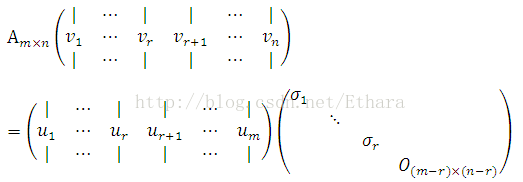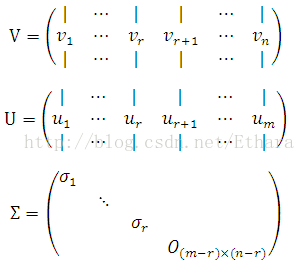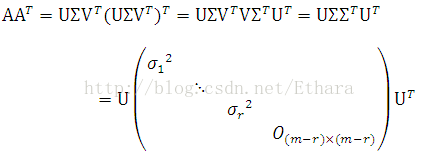Meditation on Singular Value Decomposition
Meditation on Singular Value Decomposition
Ethara
Singular Value Decomposition (SVD) is considered as the final and best factorization of a matrix, as described by Professor Gilbert Strang from Massachusetts Institute of Technology. Here is what SVD says,
Any matrix A whatsoever can be decomposed into
![]()
where SIGMA is a diagonal matrix, U and V are two orthogonal matrices.
Question is, how could it become possible? After thorough meditation, I will give a natural motivation to this perfect decomposition of a matrix in this paper.
Figure 1. Four fundamental subspaces of matrix X
Proof on SVD
Suppose we are given an m-by-n matrix X whose rank is r. Since any matrix can be viewed as comprised of four fundamental subspaces, we can depict Figure 1 for matrix X.
Through Gram-Schmidt orthogonalization, we can always obtain all of the orthonormal bases in each subspace of X, which are,
v1, …,vr are orthonormal bases in the row space of X,
vr+1, …,vn are orthonormal bases in the null space of X,
u1, …,ur are orthonormal bases in the column space of X,
ur+1, …,um are orthonormal bases in the left null space of X.
Here comes a challenging problem which will motivate SVD naturally. We are asked to find a linear transform given by an m-by-n matrix A that makes a subtle connection between the row space and the column space, i.e.,
![]()
where
![]()
Furthermore, taking the null space and the left null space of X into consideration, we can express this problem explicitly into the following equation.
Letting
yields
![]()
Since V is an orthogonal matrix, V is invertible and V-1=VT. We can obtain Equation (*),
![]()
Thus, if we can find appropriate matrices U, V and SIGMA, the proof on SVD is done. Now, let’s find them.
Using Equation (*), we have,
Noting that ATA is a symmetric matrix, moreover, an n-order symmetric matrix S has n independent eigenvectors and can be decomposed as,
![]()
where the columns of Q are the eigenvectors of S and LAMBDA is a diagonal matrix with the eigenvalues of S, we can conclude that the columns of V are just the eigenvectors of ATA and the entries on the primary diagonal in the diagonal matrix between V and VT are just the eigenvalues of ATA.
Likewise, we can find U in exactly the same way,
Therefore, similarly, the columns of U are just the eigenvectors of AAT and the entries on the primary diagonal in the diagonal matrix between U and UT are just the eigenvalues of AAT.
Since V, U and SIGMA have been nailed down, now it’s time to declare our victory of proving the Singular Value Decomposition. Any matrix A whatsoever can be decomposed into
![]()
Postscript
Laymen are always looking upon a matrix as a simple box of numbers, while mathematicians like us are able to see what’s typically inside of this magical box, i.e., four fundamental subspaces of a matrix.




